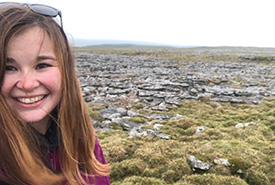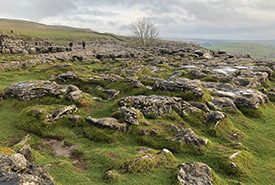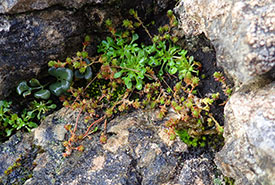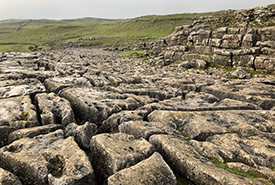Alvar explorations of a wandering biologist (part one)

Esme on the alvar in Malham Cove, U.K. (Photo by Esme Batten/NCC staff)
“You are going to drive seven hours away to go walk around on flat rocks?” my Grandad asked when I told him about my planned trip to Malham Cove in the U.K. at the end of 2018. To most people, alvars, or limestone plains, as they are called in the U.K., more closely resemble parking lots than globally rare habitat types. However, these incredible natural areas support an amazing diversity of species that can be found nowhere else in the world, and I wasn’t passing up an opportunity to explore an alvar in the land of my birth.
Now, you might be wondering what alvars are. Alvars are naturally open habitats with little to no soil. They cover either limestone or dolostone bedrock that are home to a distinctive set of plant species. They vary in terms of their total coverage of shrubs, trees, herbaceous plants, mosses and lichens.
Related content

Alvar in Malham Cove, U.K. (Photo by Esme Batten/NCC staff)
Back in Canada, I work for the Nature Conservancy of Canada (NCC) as the coordinator of conservation biology for the Saugeen Bruce Peninsula. So I have the privilege of working in some of the most intact alvar communities in the world. Approximately 60 per cent of the world’s alvars occur in Ontario. They can also be found around the remainder of the Great Lakes Basin and Manitoba, the Baltic Region of Europe, Ireland and, of course, the U.K. There are five generally accepted groups of alvars in Ontario:
- Pavement;
- grassland;
- shrubland;
- savannah;
- and woodland.

The plant species that call alvars home are extremely hardy. (Photo by Esme Batten/NCC staff)
Alvars are extremely harsh ecosystems, so the plant species that call them home are extremely hardy. The thin soils of alvars provide little insulation or water retention, and alvar plants in Ontario must survive extreme cold in the winter, intense heat in the summer and periods of severe flooding and drought annually. For alvars, these tough conditions, along with occasional wildfires, provide the disturbances that keep soil from accumulating and maintain the alvars’ open conditions. Without these disturbances, alvars are at risk of transitioning from open to wooded habitat through a process called succession. In order to protect habitat for globally, nationally and provincially rare alvar species, conservation land managers may use tools such as prescribed burns and manual shrub removal to maintain open conditions and promote native alvar plant communities.

Alvar in Malham Cove, U.K. (Photo by Esme Batten/NCC staff)
One of the biggest questions that my coworkers and I have been discussing recently is how we maintain open alvar communities in the areas where we work, when we don’t have a clear idea if or how they were maintained in the past. There is evidence in the scientific literature and fire records that some might be maintained by fire, while others might be maintained by wind or water erosion if they are close to the shorelines of the Great Lakes. In the recent past, many of these communities would have been maintained by grazing livestock, although this presents challenges because cattle can introduce non-native and invasive plant species and can cause unnaturally high levels of trampling, which damages sensitive soils and lichen communities. However, there is also discussion that they actually might not have even been maintained. Perhaps they just exist on the landscape, and as one succeeds (or grows in); others are created elsewhere on the landscape. Complex, isn’t it? This isn’t a discussion reserved only for NCC staff either. Land managers, researchers and biologists across North America and the world are grappling with these questions. So, I thought, why not explore an alvar in the U.K. to see how similar U.K. alvars are to Canadian alvar communities, and perhaps get an idea of how they might even be maintained.
Stay tuned for part two, coming out April 25, 2019.


